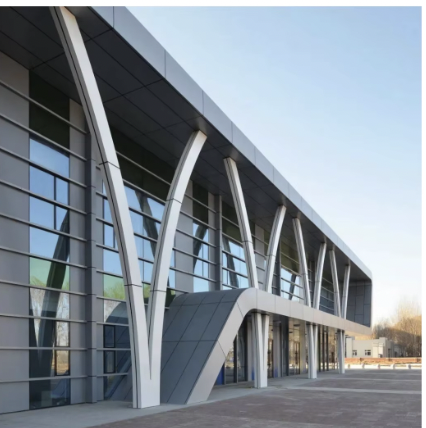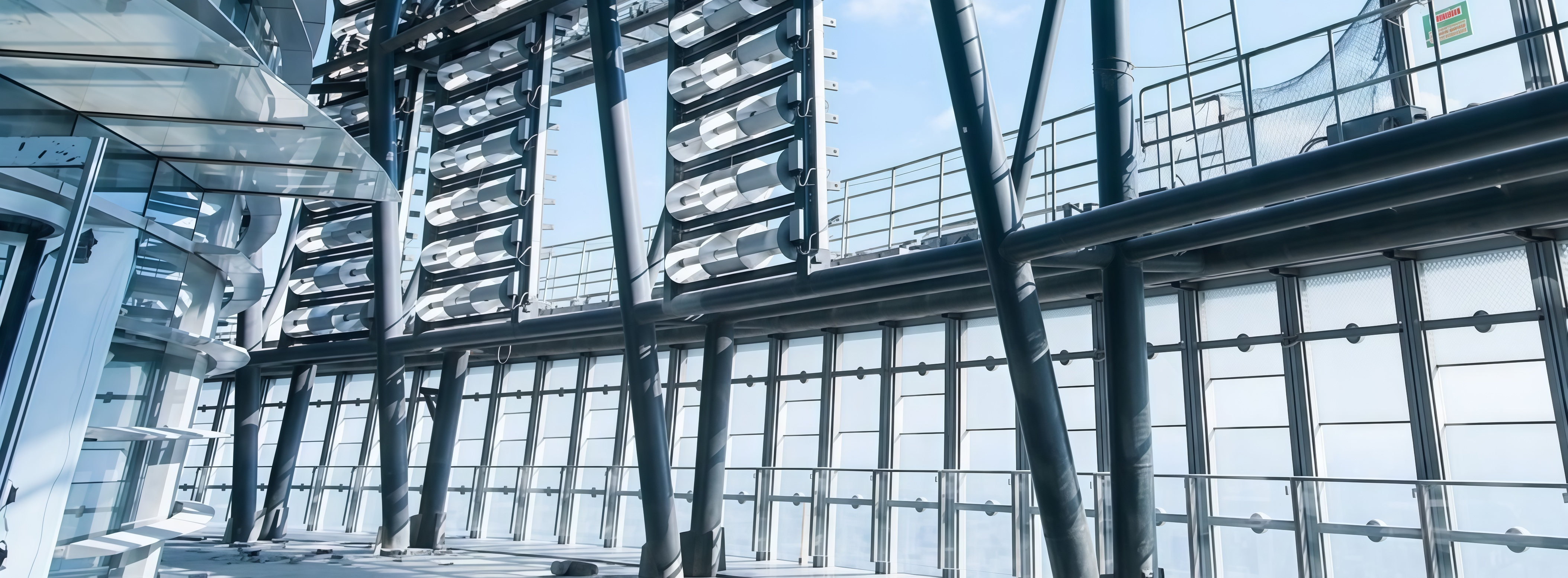O papel crítico do aço na construção de edifícios públicos
Edifícios de estruturas de aço: definição de infraestruturas públicas modernas
Os edifícios de aço tornaram-se muito importantes para as cidades, especialmente quando se trata de criar espaços públicos fortes e flexíveis. A indústria da construção viu o uso de aço aumentar constantemente nos últimos anos, e as estruturas de aço agora representam uma maior parte dos projetos de construção em todo o mundo. Tomemos o que a Associação Mundial do Aço encontrou, por exemplo, a sua pesquisa mostra aplicações de aço crescendo cerca de 5% a cada ano em obras de construção. Estamos a ver esta tendência em todo o lado, desde arranha-céus nas grandes áreas metropolitanas até centros comunitários em cidades menores. O motivo? O aço funciona melhor para muitas necessidades de construção modernas do que os materiais tradicionais. À medida que as cidades continuam a expandir-se e as necessidades de infraestrutura evoluem, o aço continua a estar na vanguarda da inovação arquitetônica e da praticidade.
O aço destaca-se como a melhor escolha para infraestruturas públicas duráveis por ser resistente, ecológico e adaptável. Quando os edifícios precisam suportar o tempo severo sem cair, o aço continua forte ano após ano. O que faz o aço ainda melhor? Pode, na verdade, ser reciclado repetidamente sem perda de qualidade, o que reduz os resíduos dos canteiros de obras. Isto significa menos tensão no nosso planeta, enquanto ainda se constroem estruturas sólidas. O dinheiro economizado ao longo do tempo também se soma, visto que esses edifícios duram mais e exigem menos reparos. À medida que as cidades de todo o mundo tentam tornar-se lugares mais ecológicos para viver, escolher materiais como o aço ajuda a atingir esses objetivos de sustentabilidade sem sacrificar a qualidade ou a segurança.
Tomemos a One Angel Square em Manchester como prova do que o aço pode fazer para edifícios públicos. Construído com estruturas de aço, este projeto reduziu o tempo de construção e economizou dinheiro durante sua vida útil. Terminado antes do prazo, significava rendimentos mais rápidos para os investidores, além de necessitarem de menos materiais, porque o aço é forte e leve. Olhando para projetos como este mostra porque estruturas de aço funcionam tão bem para cidades em rápido crescimento. Eles também economizam dinheiro a longo prazo. Quando olhamos para todos estes exemplos do mundo real, uma coisa fica clara: o aço não está apenas a sustentar os nossos horizontes, está a sustentar comunidades inteiras com a sua durabilidade e eficiência.
Integridade estrutural através da distribuição adequada da carga
Princípios de engenharia para gerenciamento de estresse
Compreender bem como o estresse funciona nas estruturas de aço é muito importante para manter os edifícios firmes. No centro disto estão duas ideias principais: forças de tensão e compressão que determinam onde o peso é distribuído corretamente em qualquer estrutura. A maioria dos engenheiros de hoje depende muito de algo chamado Análise de Elementos Finitos, ou FEA, durante o processo de projeto. Basicamente, a FEA permite-lhes ver exatamente onde as tensões podem acumular-se em diferentes condições antes mesmo de começar a construção. Sem estas simulações, falhas inesperadas poderiam acontecer no caminho de pontos de pressão ocultos que ninguém viu vir. O campo também continua a evoluir, de modo que muitos profissionais se certificam de que continuam a aprender novos métodos e materiais regularmente. Afinal, ninguém quer lidar com reparações caras causadas por cálculos de carga inadequados mais tarde.
Prevenção da fadiga estrutural em zonas de alto tráfego
Os edifícios públicos enfrentam sérios problemas de fadiga estrutural, particularmente onde muitas pessoas passam diariamente. O que acontece é bastante simples, os materiais são pressionados repetidamente até que começam a falhar. Esta degradação gradual pode causar problemas de segurança reais se não for controlada. Manter-se atualizado com verificações regulares de manutenção e incorporar projetos mais inteligentes ajuda muito a prolongar o tempo em que as estruturas permanecem seguras. Alguns materiais mais novos realmente lidam com a distribuição de peso muito melhor do que os tradicionais, reduzindo consideravelmente esses riscos de fadiga. Vimos muitos casos em que ignorar estes sinais levou a grandes falhas em diferentes tipos de projectos de construção. Os números que confirmam isto estudos muito recentes mostram que os edifícios mantidos devidamente têm taxas de falha cerca de 40% menores do que os negligenciados. É por isso que as inspeções contínuas são tão importantes para lugares como escolas, hospitais e centros comerciais onde o tráfego pedonal constante tem seu preço dia após dia.
Garantir a segurança a longo prazo com a solda de precisão
Obter a precisão certa no trabalho de soldagem está no centro da construção de estruturas de aço que duram e mantêm as pessoas seguras em espaços públicos. A maioria dos empreiteiros depende de métodos como a soldagem MIG e TIG para criar essas conexões sólidas entre as peças metálicas. Mas para garantir que estas juntas resistam, é necessário estar constantemente vigilante no que se refere ao controlo de qualidade. Os inspetores precisam examinar cada solda cuidadosamente durante a construção para detectar qualquer defeito no início. Porque é que isto importa tanto? A mal soldadura já causou grandes desastres antes. Veja o incidente da Torre Champlain como apenas um triste exemplo de que a soldagem deficiente contribuiu para sérios problemas estruturais. É por isso que os construtores inteligentes sempre alocam tempo e recursos para protocolos de inspeção adequados e contratam soldadores experientes que sabem o que estão a fazer. O resultado final? Edifícios que resistem ao teste do tempo sem comprometer os padrões de segurança.
Metodologias de parafusos para resistência sísmica
As estruturas de aço precisam de bons métodos de parafusos se quiserem resistir a terremotos, especialmente onde os terremotos acontecem regularmente. Quando os engenheiros fazem o parafuso certo, os edifícios sobrevivem a tremores sem perder a sua força básica. Paralelamente, os parafusos pesados, as âncoras de expansão e as técnicas de pré-tensão ajudam a espalhar a tensão por todas as conexões entre diferentes partes da estrutura. Isto torna muito menos provável que algo se quebre quando o chão começar a se mover. Seguir códigos de construção como o IBC e o Eurocode não é apenas papelada, estas regras contêm conhecimento real sobre o que funciona melhor na prática. Construtores que as ignoram acabam com edifícios que não funcionam como esperado durante eventos sísmicos reais. A maioria dos construtores experientes sabe por experiência que seguir os requisitos do código economiza dinheiro e vidas a longo prazo.
Desempenho Ambiental e Conforto
Técnicas de isolamento acústico
A acústica é muito importante em locais onde as pessoas se reúnem, especialmente quando se trata de edifícios de aço. O aço não é só forte e dura para sempre, mas os arquitetos descobriram formas de trabalhar com ele para que ajude a controlar o ruído também. Eles colocam painéis acústicos dentro das paredes ou usam material isolador especial entre as camadas de aço para impedir que sons indesejados rebentem por toda parte. As bibliotecas precisam de espaços silenciosos para ler, as salas de aula precisam de áudio claro para apresentações e os hospitais se beneficiam de ruídos de fundo reduzidos em todo o lugar. Estudos mostram que estes métodos reduzem o ruído perturbador em até 40% em alguns casos. As pessoas que passam tempo em espaços acústicos bem concebidos relatam uma melhor concentração durante as tarefas e geralmente se sentem menos estressadas. Faz sentido quando pensamos no quanto o ruído de fundo constante pode ser irritante depois de um tempo.
Eficiência térmica em edifícios públicos de aço
No que diz respeito aos edifícios públicos de aço, a eficiência térmica desempenha um papel importante tanto na economia de dinheiro como na conservação de energia ao longo do tempo. Para conseguir isso, é preciso escolher os materiais e as técnicas de construção certos que realmente fazem a diferença na quantidade de aquecimento e arrefecimento que o edifício precisa durante todo o ano. O aço funciona bem quando combinado com bom isolamento e superfícies refletoras, o que ajuda a manter a temperatura interna estável e reduz as contas de energia. Os testes realizados no mundo real demonstraram que os edifícios concebidos com uma gestão térmica adequada podem reduzir os custos operacionais em cerca de 30% em comparação com as construções normais. Para os urbanistas e arquitetos que trabalham em projetos públicos, a incorporação dessas considerações térmicas faz sentido tanto do ponto de vista ambiental como do orçamento. Afinal, ninguém quer pagar por desperdício de energia desnecessário em espaços comunitários como bibliotecas ou escritórios governamentais.

Conformidade regulamentar e adesão ao código
Navegando pelas normas internacionais de construção
Conhecer as normas internacionais de construção faz toda a diferença quando se construem estruturas de aço. Estes edifícios devem cumprir diferentes normas globais em todos os países, e ignorá-los pode levar a sérios problemas de segurança no futuro. Todo o processo começa muito antes de a construção começar. Os arquitetos precisam de incorporar estes requisitos específicos nos seus planos desde o primeiro dia. Tomemos lugares como a Califórnia e o Japão como bons exemplos, onde os construtores enfrentam regras rigorosas porque os terremotos são tão comuns lá. Eles precisam de projetos especiais que possam resistir a tremores sem falhar. Seguir esses padrões não é apenas evitar desastres. Na verdade, acelera as coisas durante as aprovações, uma vez que as autoridades reconhecem imediatamente o trabalho conforme, o que economiza tempo e dinheiro a longo prazo.
Documentação para certificação de segurança
A obtenção da certificação de segurança para edifícios públicos depende realmente de manter bons registos durante todo o processo. Os empreiteiros precisam documentar tudo, desde os planos e materiais utilizados até como as coisas foram construídas no local. Estes documentos ajudam a assegurar que todos seguem as regras de segurança e reduzem os problemas potenciais no futuro. Uma boa documentação também cria confiança entre os contribuintes que querem saber que seu dinheiro está sendo gasto com segurança. Muitos empreiteiros se metem em problemas quando esquecem de preencher documentos importantes ou de organizá-los adequadamente. Quando os documentos estão completos e fáceis de encontrar, o processo de aprovação é muito mais rápido. As empresas que se mantêm organizadas tendem a obter autorizações mais rapidamente, criando um ambiente onde a segurança se torna uma segunda natureza em toda a indústria da construção.
Perguntas Frequentes
Quais são as vantagens do uso de aço na construção de edifícios públicos?
O aço oferece durabilidade, sustentabilidade e versatilidade, tornando-o ideal para infraestrutura pública. Resiste a condições climáticas extremas e é reciclável, contribuindo para a redução de custos e eficiência ecológica.
Como a soldagem de precisão aumenta a segurança das estruturas de aço?
A soldagem de precisão garante juntas fortes e evita falhas estruturais. Inspeções regulares e soldadura qualificada são cruciais para a longevidade e segurança dos edifícios.
Qual o papel do parafuso na resistência sísmica das estruturas de aço?
Os métodos de parafusos distribuem a tensão entre as juntas, garantindo que os edifícios resistam às forças sísmicas sem comprometer sua integridade.
Por que é importante a eficiência térmica nos edifícios públicos de aço?
A eficiência térmica reduz os custos energéticos através da otimização da regulação da temperatura, oferecendo benefícios económicos e de sustentabilidade significativos.
Sumário
- O papel crítico do aço na construção de edifícios públicos
- Integridade estrutural através da distribuição adequada da carga
- Garantir a segurança a longo prazo com a solda de precisão
- Metodologias de parafusos para resistência sísmica
- Desempenho Ambiental e Conforto
- Conformidade regulamentar e adesão ao código
- Perguntas Frequentes






